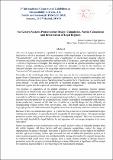Search
Sui Generis Systems Protection for Design: Cumulation, Partial Cumulation and Demarcation of Legal Regimes

View/
Author
Date
2023-01-31Publisher
Global Academy Publishing HouseCitation
Ipatova, O. Sui Generis Systems Protection for Design: Cumulation, Partial Cumulation and Demarcation of Legal Regimes / O. Ipatova // Proceedings Book ICSSIET Congress : 1st International Congress and Exhibition on Sustainability in Music, Art, Textile and Fashion (ICESMATF 2023), January, 26-27 Madrid, Spain / Edited by Shajara Ui Durar. – Ankara : Global Academy Publishing House, 2023. – P. 73–94.Abstract
The use of design decisions is regulated in most countries by sui generis legislation (special
legislation), which is associated with the uniqueness of the legal design of an industrial design, its
“incompatibility” with the established legal classification of intellectual property objects:
inventions and utility models protect the technical side of the product, copyright and related rights
- a form of expression of thought. The emergence of a special sui generis protection regime for
industrial design, embodying aesthetic and utilitarian principles, is due to the similarity of
industrial designs with works of art (copyright objects) and trademarks and, as a result, “mixing”,
“intersection” of copyright and industrial property.
Currently, in the world legal order, there are three systems for the correlation of copyright and
patent forms of protection for designs: cumulative protection, partial cumulative protection, and
delimitation of protection regimes. Speaking about the patent form of protection, we need to look
more broadly - to talk about the protection of industrial property rights, including both the
trademark regime and the regime of protection against unfair competition.
The position of supporters of the partial operation of design protection regimes (partial
cumulation) is based on the thesis that full copyright protection is not required, inappropriate and
harmful for a number of reasons. First, despite the lack of full copyright protection, the power of
copyright is sufficient to support an ever-growing design industry. Secondly, current design laws
also provide some protection for design decisions. Thirdly, copyright is incompatible with industry
(mass production) because of the doctrine of utilitarian (useful) things and the difficulty of
distinguishing original works from non-original ones. The fourth reason is that ensuring full
copyright protection will lead to more litigation, more fear of creativity, and more business value.
Because of this, an intermediate option - a system for the protection of special industrial designs
with partial cumulation - is currently the most acceptable for most legal orders. This special design
protection system only protects designs that are "exceptionally original". This level of protection
and the high threshold for legal liability for infringement will encourage designers to be more
innovative.
Such a sui generis system would remove only a small, exclusive class of industrial designs from
the public domain. All these factors will only promote competition, reduce the range of
opportunities for abuse of the right - the claims of authors for violation of their right to inviolability
and the right to processing. Such a high threshold does not invalidate the protection system, as it
aims to protect against products that could potentially damage the market for original designs due
to confusion that could result from copying. Only a small, limited number of designs deserve
protection under the sui generis industrial designs system. Otherwise, a legal basis will be created
for numerous lawsuits that will increase prices for manufactured products.
Collection

Это произведение доступно по лицензии Creative Commons «Attribution-NonCommercial» («Атрибуция-Некоммерчески») 4.0 Всемирная.